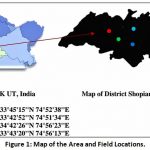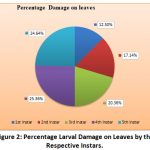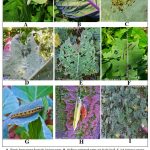Introduction
Cabbage butterfly (Pieris brassicae L.) belongs to family Pieridae of order Lepidoptera. It is a holometabolous insect having four stages in their life cycle i.e. egg, larval with 5 instars, pupa also known as chrysalis and adult. The adults feed on the nectar of flowers and sometimes assume the service of pollination. However, the larvae are voracious polyphagous pests of many Brassicae crops such as Kale, cabbage, cauliflower and so on. The adult Pieris brassicae can be easily recognized by the colour pattern of their wings which are either white or creamy white in colour with black spots on the forewings. In females, large black spots also appear on the undersides. The head, thorax and abdomen are black with grey hair-like scales. The wing expanse of the male butterfly was 5 to 5.2 cm with an average of 5.1 cm and the wing expanse of female was 5 to 6 cm with an average of 5.5 cm. The caterpillar of the Pieris brassicae has been considered a notorious pest in many countries including India. The larvae can damage the leaves as well as the whole crop if measures are not taken. The species are distributed throughout Europe, North Africa and Asia.1,2,5 The larvae of Pieris brassicae, if not controlled can damage a large proportion of the crop especially the vegetable crops of the family Brassicaceae. The study was designed to assess the damage done by the larvae of Pieris brassicae.
Brassicae oleraceae L. are mostly biennial or perennial herbs and are rarely annual. The stems are erect or decumbent, branched at or above the middle and sometimes fleshy at the base. Basal and lowermost cauline leaves are long petiolate, sometimes strongly overlapping and forming a head. However, in the case of Var. Virdis, there is an absence of a head at the top. The leaf blade is ovate, oblong, or lanceolate in outline, margin entire, or dentate sometimes pinnatifid or pinnatisect having large terminal lobe on each side of the midvein. Upper cauline leaves are sessile or subsessile in some cultivated forms. Racemes are sometimes fleshy and condensed into a head while fruiting pedicels usually straight ascending or divaricate. Sepals are oblong while petals are creamy yellow or rarely white. Anthers are oblong while fruits linear, terete, sessile or on a gynophore, divaricate or ascending; valvular segment valves with a prominent midvein; terminal segment conical. Seeds are dark brown or blackish and globose. Fl. March-June, Fr. April-July. Leaves broad loosely grouped into an open head in case of var. virdis and the mature stem becomes pinkish in colour.7
The marrow stem kale (Haak or Kashmiri Saag) is believed to be originally cultivated by the Greeks during ancient times and was introduced to the Kashmir Valley by their close cousins, the Macedonians. A number of varieties (Genotypes) of Kashmiri Haak are cultivated in the agricultural and rural areas of Kashmir valley at a very large-scale which makes this particular vegetable crop very famous across the Kashmir valley. Most of the vegetable crop is consumed as fresh throughout the year and a small proportion is used to make pickle which is consumed during the winters. Brassicae oleraceae comprises of highly nutritious vegetable crops that are rich in vitamins, minerals, potassium, iron calcium, magnesium and high concentrations of antioxidants.3,4 Some varieties are grown in winter and summer respectively. These varieties are distinguished by season, thickness and length of their stems. The marrow stem kale and other varieties are the most consumed vegetables across Kashmir Valley.6,8
Materials and Methods
The study was designed to assess the damage on the leaves of Marrow Stem Kale by the polyphagous caterpillars of Pieris brassicae. A total of four locations (Fig. 1) were chosen for the observation and analyzed the larval incidence and leaf damage to the vegetable crop. A total of four locations were chosen for the study. Two field plots were chosen in each of the four locations as insecticide treatment and non-insecticide treatment. The insecticide treatment plot was provided with the timely spray of insecticides and pesticides as most of the other vegetable crops grown in the area. Similarly, the non-insecticide treatment plot was cultivated away from other vegetable crops and no insecticide spray was given to it in four locations respectively. A total number of four surveys were carried out and for every week, the counts were obtained in all the locations and the plots. For every week, a count was carried out in the respective locations. The larval incidence and leaf damage counts were analyzed on both the insecticidal and control field. The crop was usually treated with insecticides viz. Chlorpyriphos and Fenthion by the farmers. Similarly, the control plot was selected on all four locations. The photographs were taken using Redmi Note 8 Pro smartphone with a 20mm macro lens attached. The percentage of leaf damage and larval incidence were calculated by the following formula:
![]()
![]()
A total of four field plots were taken for the observation and assessment of the leaf damage of vegetable crops and larval incidence by the pest. The four field plots comprising of the fully-grown vegetable crop were 10×10 ft, 10×12 ft, 12×11 ft and 11×10 ft in length and width respectively. A count of fully grown plants was taken into consideration for the damage report of the leaves on particular plants by the pest caterpillar (Table 1). The data were analyzed using statistical analysis of Microsoft Excel 2016 and the difference between means of the two treatments were evaluated using a t-test.
Table 1: Sample Size and Total Number of Leaves and Plants Checked for Pest Infestation.
| No. of Plots | Total Area (Length x Width) | Total No. of Plants | Total no. of Leaves |
| Plot 1 | 10×10 ft | 14 | 90 |
| Plot 2 | 10×12 ft | 15 | 84 |
| Plot 3 | 12×11 ft | 11 | 68 |
| Plot 4 | 11×10 ft | 12 | 78 |
 |
Figure 1: Map of the Area and Field Locations. |
Results
The present study assessed the larval incidence and leaf damage of Brassica oleracea L. var virdis, on the marrow stem kale. The larvae of Pieris brassicae are voracious feeders as they are well equipped with biting and chewing mouthparts. The female species lays her eggs on the underside of a marrow stem leaf by bending the abdomen. A pale-yellow pack of cylindrical eggs can be seen on the underside of the leaf or sometimes on the leaf. A four moulting and five instars completes the life stages till the pupa (chrysalis). The body measurement and morphological characteristics of the larval stages are given in Table 2.
In the case of the insecticide treatment, minimum leaf damage was observed as 0.2% (1st count) and larval incidence was observed as 0.04% (1st count) and the maximum leaf damage was observed as 0.45% (4th count) and the larval incidence was observed as 0.36% (3rd count). The pest was observed to significantly and negatively influence the crop. All the pest characteristics were observed to decrease with increasing insecticide treatment (Table 3 and 4). In case of the non-insecticide treatment, minimum leaf damage was observed as 1.36% (1st count) and larval incidence was observed as 0.44% (1st count) and the maximum leaf damage was observed as 3.15% (4th count) and the larval incidence was observed as 1.13% (4th count) (Table 3 and 4). The counts were obtained in the respective instars of the larvae. The highest leaf damage was observed by the 4th instar (7.1%) followed by the 5th instar (6.9%), 3rd instar (5.7%), 2nd instar (4.8%) and 1st instar (3.5%) respectively (Fig. 2). The life cycle of Pieris brassicae is shown in Figure 3.
Table 2: Morphological Characters of Egg and Larval Stages of Pieris brassicae.
| Life Stage | Length (mm) | Width (mm) | Morphological Characters |
| Eggs | 1.20 to 1.32 | 0.40 to 0.48 | Yellow colour, cylindrical, sculptured like a maize comb. |
| 1st instar | 5.9 to 6.1 | 0.7 to 1.1 | Pale yellow and head black. |
| 2nd instar | 11.8 to 12.4 | 2.1 to 2.4 | Greenish yellow and blackhead with short body hairs. |
| 3rd instar | 22.9 to 23.5 | 2.9 to 3.3 | Greenish and blackhead with black hairs on raised tubercles. Five longitudinal yellowish lines one dorsally and two laterally on each side of the body. |
| 4th instar | 31.9 to 32.3 | 4.1 to 4.2 | Same as the 3rd instar but with increased length and width of the body. |
| 5th instar | 39.0 to 40.1 | 5.1 to 5.4 | Yellow and greenish in colour, cylindrical, robust and elongated with bright coloration with head black. Longitudinal lines on the body were similar to the fourth instar. Body covered with black hairs on raised tubercles. |
Table 3: Effect of Insecticide Treatment on Mean Leaf Damage per Plant (Mean±SD) (n=4)
| Treatment | 1st Count | 2nd Count | 3rd Count | 4th Count |
| Insecticide | 0.17 ± 0.07 | 0.17 ± 0.09 | 0.27 ± 0.05 | 0.38 ± 0.06 |
| Control | 1.44 ± 0.06 | 1.96 ± 0.38 | 2.13 ± 0.36 | 2.66 ± 0.33 |
| t-value | -26.01997 | -8.92565 | -10.09135 | -13.43989 |
| p-value | 0.00001 | 0.000055 | 0.000027 | 0.00001 |
| df | 3 | 3 | 3 | 3 |
| Result | significant at p < .05 | significant at p < .05 | significant at p < .05 | significant at p < .05. |
Table 4: Mean Percent Larval Population of Pieris brassicae per Plant.
| Treatment | 1st Count | 2nd Count | 3rd Count | 4th Count |
| Insecticide | 0.09 ± 0.04 | 0.09 ± 0.04 | 0.23 ± 0.09 | 0.21 ± 0.06 |
| Control | 0.53 ± 0.12 | 0.72 ± 0.13 | 0.86 ± 0.10 | 1.01 ± 0.09 |
| t-value | -6.87332. | -9.15749 | -9.07492 | -13.51646 |
| p-value | 0.000234. | 0.000048 | 0.00005 | 0 .00001 |
| df | 3 | 3 | 3 | 3 |
| Result | significant at p < .05 | significant at p < .05 | significant at p < .05 | significant at p < .05 |
 |
Figure 2: Percentage Larval Damage on Leaves by the Respective Instars. |
 |
Figure 3: Life Cycle of Pieris brassicae and the Damage to Marrow Stem Kale. |
Discussion and Pest Control Recommendation
The present study thoroughly monitored the life cycle of Pieris brassicae and the damage and larval incidence on the Brassica oleracea L. var virdis. The larvae of the Cabbage white butterfly can pose a serious threat on the brassicae crops since the larvae are equipped with biting and chewing mouthparts. The larval incidence of this species, if not controlled at the early stages can damage a large area or a whole crop. After monitoring and observing the pest species in the present study, the damage of the larval instars on the crop can be controlled manually. As the adult butterfly is not a pest and only the larvae can pose damage to the crop, therefore a timely observation is needed to check the presence of pale-yellow eggs or larvae, which are given in the photo plate. If there is a presence of eggs on a particular leaf, it is encouraged that the leaf should be removed and thrown outside of the field or vegetable lawn which will save the time and utilization of harmful pesticides. The larvae can also be removed by hands as well, therefore saving the crop from further infestation.
Conflicts of Interest
The authors declare no conflict of interest.
Acknowledgement
The authors wish to thank Entomology Research Institute, Loyola College, Chennai-34 for extended support and guidance and Dr. Michael Gabriel Paulraj (Senior Scientist, Guru Nanak College, Chennai) for his valuable suggestions and recommendations throughout this study.
Funding Source
The present study receives no funding.
References
- Ahmad H., Shankar U., Monobrullah M., Singh S., Abrol DP., Kaul V. Seasonal incidence and management of cabbage butterfly, Pieris brassicae (Linn.) in Jammu. Environment and Ecology. 2007;25(2):429.
- Bhowmik M., Gupta M. Biology of Cabbage Butterfly Pieris brassicae (Lepidoptera: Pieridae). International Journal of Current Microbiology and Applied Sciences. 2017;6(12):3639-44.
CrossRef - Cao G., Sofic E., Prior RL. Antioxidant capacity of tea and common vegetables. Journal of agricultural and food chemistry. 1996 Nov 14;44(11):3426-31.
CrossRef - Gull, F. Anthropology of Food: A Study on the Feeding Habits of Kashmiri Muslims. Antrocom: Online Journal of Anthropology. 2020 Jul 1;16(2).
- Jainulabdeen S., Prasad SK. Severe infestation of cabbage butterfly, Pieris brassicae (Linnaeus) on six species of Brassica and effect of abiotic factors on its population dynamics. Journal of Entomological Research. 2004;28(3):193-7.
- Khan SH., Ahmad N., Jabeen N., Chattoo MA., Hussain K. Biodiversity of kale (Brassica oleracea var. acephala) in Kashmir Valley. Asian Journal of Horticulture. 2010;5(1):208-10.
- Khan SH., Ahmed N., Jabeen N., Mushtak F., Hussain K. Genetic divergence in kale (Brassica oleracea var. acephala). Asian Journal of Horticulture. 2009;4(1):134-7.
- Sharma A., Rana C. Collard. In: Vegetable Crops Science 2017 Oct 2 (pp. 335-344). CRC Press.
CrossRef


